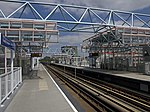De Terp metro station
1994 establishments in the NetherlandsCapelle aan den IJsselEuropean rapid transit stubsNetherlands transport stubsRailway stations opened in 1994 ... and 2 more
Rotterdam MetroSouth Holland geography stubs

De Terp is a subway station on Line C of the Rotterdam Metro and is situated in the town of Capelle aan den IJssel, in the Oostgaarde area, just east of Rotterdam. It is the northern terminus of the line. The station was opened on 26 May 1994 as part of the extension of the East-West Line or Caland Line from Capelsebrug station. The station consists of an island platform between two tracks. Near the Subway station is Shopping Mall De Terp. Also RET Bus 31 to Rotterdam Alexander stops once in a half-our near the station.
Excerpt from the Wikipedia article De Terp metro station (License: CC BY-SA 3.0, Authors, Images).De Terp metro station
Westerlengte,
Geographical coordinates (GPS) Address Nearby Places Show on map
Geographical coordinates (GPS)
| Latitude | Longitude |
|---|---|
| N 51.935963888889 ° | E 4.6004722222222 ° |
Address
De Terp
Westerlengte
2905 AW
South Holland, Netherlands
Open on Google Maps








